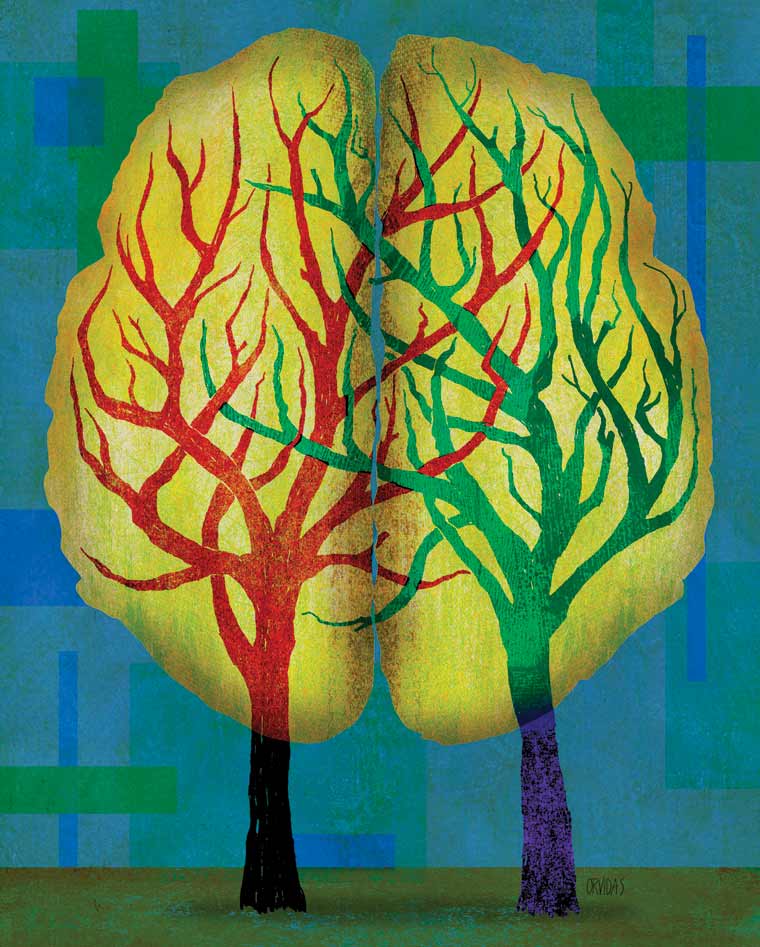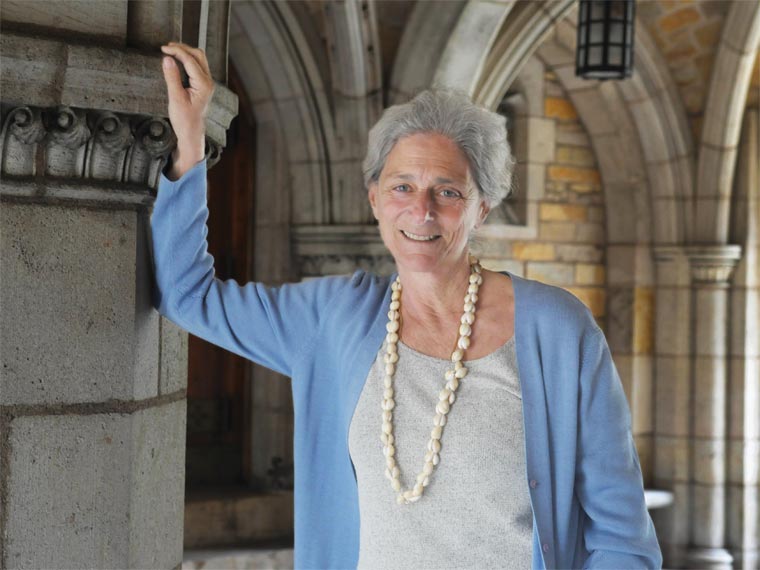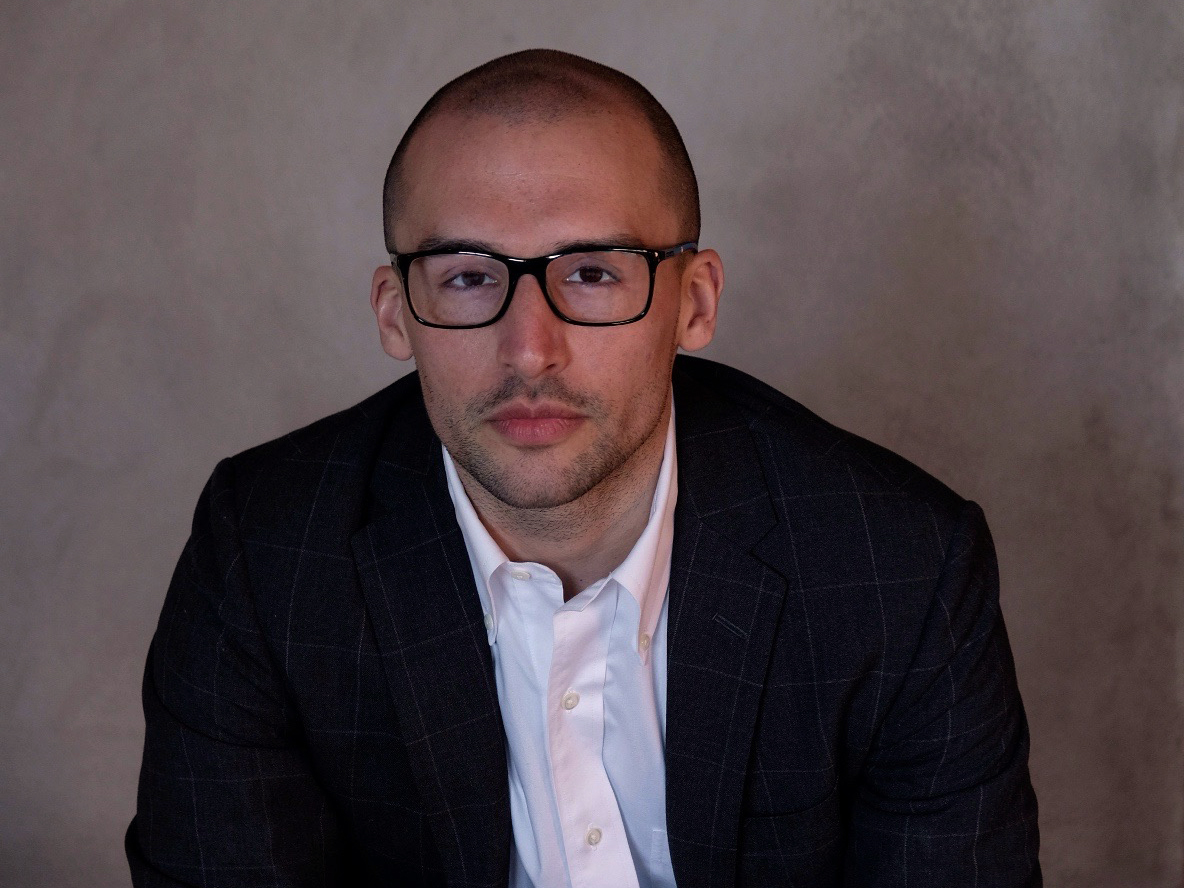They studied at Sarah Lawrence half a century apart and conduct medical research on separate continents. So how do Laura Kirchman Manuelidis ’63 and Charles Paccione ’13 have so much in common?

Five decades and nearly 4,000 miles separate them, but Laura Kirchman Manuelidis ’63 and Charles Paccione ’13 have trod strikingly similar paths to get to where they are. Indeed, less than five minutes into their first conversation, which took place via a trans-Atlantic phone call last fall, Manuelidis and Paccione discovered some remarkable points of convergence in their lives. Both were born in Brooklyn. Both were artists—Manuelidis a poet and Paccione a classical violinist. And both, of course, attended Sarah Lawrence, though they graduated exactly half a century apart.
Perhaps most tellingly, both chose to pursue a form of medicine that focuses on the mind. Manuelidis is a neuropathologist at Yale, studying diseases of the brain, from cancer to Alzheimer’s to mad cow disease. Her prize-winning research into DNA uncovered the integration of environmental viruses into the human genome. Paccione is a researcher in integrative medicine and chronic pain at Oslo University Hospital. He studies how the brain processes pain and can be harnessed to mitigate that pain. His research focuses on meditation as therapy, and he created a meditation program for veterans suffering from PTSD. He also developed an innovative method of utilizing meditative-based deep-breathing techniques to treat chronic widespread pain and the depression and anxiety that often accompany it.
Both Manuelidis and Paccione display a knack for finding connections among the seemingly unconnected. She sees a synergy, for example, between poetry and medicine, noting that each discipline highlights the importance of listening. In high school, she couldn’t understand Chapman’s translation of The Odyssey until her mother read it to her aloud. Medicine, she says, particularly the art of diagnosis, “is also about listening and observing.”
Paccione agrees. In 2016 he published an essay about the interaction between doctor and patient whose title, “Try to Be an Ear,” was taken from a poem by the 13th-century Persian poet known as Rumi. In the essay, Paccione likens the patient to a storyteller and the doctor to a listener, quoting Rumi: “Listen.. Keep silent. You are not God’s mouthpiece. Try to be an ear. And if you do speak, ask for explanations.”
As scientists who find poetry in medicine, both Paccione and Manuelidis are troubled by the cultural tendency to view art and science as separate, even diametrically opposed, disciplines. “They’re very intertwined,” Manuelidis says. “Look at Darwin and [William] Harvey—great scientists and great writers.”

Long before she studied poetry at Sarah Lawrence, Manuelidis was a passionate reader and writer. She remembers being overwhelmed by Samuel Taylor Coleridge’s visionary poem “Kubla Khan” at the age of 14 and thinking, He’s on opium. That moment helped spark an interest in hallucinations, which fed into her fascination, in college, with schizophrenia and, eventually, the brain.
Paccione’s own curiosity about the brain also began in adolescence. He started meditating at 12, eventually delving into various forms of the practice and, he says, “acting as my own test subject, noting how it was affecting me, behaviorally, emotionally, cognitively.”
His embrace of music began even earlier. “I was around 6,” he remembers, “and at my school I saw a little boy alone on stage, playing the violin.” At that moment, he says, he was compelled to learn how to play. His parents gave him a violin, and he’s been playing ever since. Today he works with a pianist, and the two give concerts throughout the year.
Manuelidis, who has published two poetry collections, continues to write even as she devotes herself professionally to research on hidden viruses in dementia. She’d intended to make poetry her life’s work, up until the time her brother asked her what she planned to do after graduation. Her reply? “I’m going to be a poet.” Her brother said he didn’t see any want ads for poets in The New York Times. “Well, then,” she answered, “I guess I’ll go to medical school.”
She’d read Freud and Jung, and during summer breaks at Sarah Lawrence, she says, “I worked with schizophrenics in mental hospitals—in the men’s and women’s locked, violent wards—and became interested in finding a cure for schizophrenia.” That didn’t happen, but she did do elegant, internationally recognized research involving DNA and has become famous for her repudiation of the highly publicized view that the infectious agent causing epidemic mad cow disease, human Creutzfeldt-Jakob disease, and endemic sheep scrapie is a misfolded normal protein known as a prion. “The data,” she says, “point to a virus with a genome. There is no reproducible evidence that any form of prion protein itself is infectious.”
She thinks the presence of abnormal prion protein in the brains of those with Creutzfeldt-Jakob is a result of infection, not its cause, since every other known infectious agent contains DNA or RNA, which prion protein lacks. That’s made her something of a provocative figure in the fields of neurology and neuroscience, but she hasn’t let the controversy derail her research into the disease and its cause. In fact, it’s the process of research that energizes her. “The question,” she says, “is more interesting than the answer.”

As the two researchers share their stories, it’s clear that neither is afraid to tread on orthodoxies. Paccione says he’s “always needed to be in spaces where I feel that not everyone is agreeing with me and I’m taking a risk to change things. You get high off of that.” While he’s an enthusiastic proponent of mindfulness meditation as a means of controlling pain, he willingly admits that it doesn’t work for everyone and every form of pain. He’s currently leading a study to determine the relative effectiveness of two approaches to controlling chronic widespread pain, including fibromyalgia: meditation versus electrical stimulation of the vagus nerve, the longest and most complex of the nerves that connect the brain to the rest of the body. If the machine does better than the mind, he’s okay with that. “If we’re wrong,” he says, “we have to meet that with humility, respect, and curiosity.”
That sense of curiosity was nurtured at Sarah Lawrence, where Paccione pursued violin and pre-medicine and met his future wife, Lise Eidsvaag MA ’12. He remembers having “one foot on the classical stage and the other in the hospital or in the city shadowing physicians.” That figurative stance compelled him to think about the ways in which music and medicine intersect, questions that arose naturally in the interdisciplinary atmosphere that prevails at Sarah Lawrence. He cites, among the answers, “music’s innate power to heal” and the way in which both DNA and Bach’s fugues involve simple forms that, when interwoven, become increasingly complex.
That same stress on the intersection among disciplines helped Manuelidis to flourish at Sarah Lawrence and beyond. “The great thing about studying at Sarah Lawrence,” she says, “was that you didn’t have to make choices.” In addition to poetry, she studied anthropology, philosophy, and medieval history. “It was great fun,” she says—which is also how she describes her work in medicine.
At one point in their long-distance conversation, Manuelidis and Paccione begin to talk about black holes, and the dialogue naturally turns to what’s lost when people refuse to see the essential connections between art and science. “I’m very sad,” Manuelidis says, “when I see people in the humanities who have no interest in understanding something like a black hole and think it is empty.” Paccione seizes on the idea of a black hole as metaphor, something you can see as empty or filled with potential. “In order to see that potential,” he continues, “you need to think across disciplines, integratively. You don’t have to make choices. Once you start being curious as to how fields can merge, you feel the world has chosen you.”
Written by Leslie Garisto Pfaff
Illustrated by Ken Orvidas
Photograph of Manuelidis by Michael Marsland
Photograph of Paccione by Simen Idsøe Eidsvåg
Brain trust
Reflecting her longtime embrace of ideas that cross disciplines, Laura Manuelidis last year established the Laura Kirchman Manuelidis Science and Literary Arts Endowment, a $100,000 gift to support student experiences that meld science and the literary arts, especially poetry. The endowment will fund varied boundary-expanding experiences and endeavors, including performances, student work, class events, lectures, and visiting speakers.